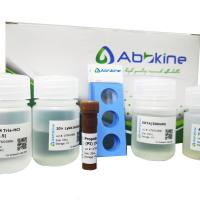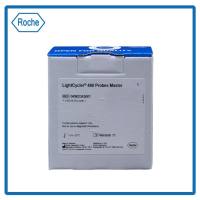ICON Probes: Synthesis and DNA Methylation Typing
互联网
- Abstract
- Table of Contents
- Materials
- Figures
- Literature Cited
Abstract
DNA methylation and demethylation significantly affect the deactivation and activation processes of gene expression, respectively. The determination of the location and frequency of DNA methylation is important for the elucidation of the mechanisms of cell differentiation and carcinogenesis and may be a useful and effective index for cancer diagnosis. We have developed an artificial DNA probe that induces a methylation detection reaction of a target cytosine in a long DNA sequence (ICON probe). This artificial DNA allows the rapid detection of a methyl group attached at the C5 position of the target cytosine. In addition, there is no nonspecific cleavage of genomic DNA in this reaction. The ICON probe also facilitates the quantification of methylation at the target cytosine using a small amount of genomic DNA sample. This unit provides a procedure for synthesizing bipyridine?modified adenosine phosphoramidite and preparation of ICON probes. Additionally, the protocol for the methylation quantification experiments by quantitative PCR utilizing ICON probes is also presented. Curr. Protoc. Nucleic Acid Chem. 47:8.7.1?8.7.17. © 2011 by John Wiley & Sons, Inc.
Keywords: ICON probe; DNA methylation; osmium; artificial DNA
Table of Contents
- Introduction
- Basic Protocol 1: Synthesis of N‐(2‐Aminoethyl) (4′‐Methyl‐2,2′‐Bipyridine‐4‐yl)Hexanamide
- Basic Protocol 2: Synthesis of a Bipyridine‐Modified Adenosine Phosphoramidite
- Basic Protocol 3: Synthesis, Isolation, and Characterization of the Icon Probe
- Basic Protocol 4: Methylation Quantification Experiments Using Icon Probes and Quantitative PCR
- Reagents and Solutions
- Commentary
- Literature Cited
- Figures
Materials
Basic Protocol 1: Synthesis of N‐(2‐Aminoethyl) (4′‐Methyl‐2,2′‐Bipyridine‐4‐yl)Hexanamide
Materials
Basic Protocol 2: Synthesis of a Bipyridine‐Modified Adenosine Phosphoramidite
Materials
Basic Protocol 3: Synthesis, Isolation, and Characterization of the Icon Probe
Materials
Basic Protocol 4: Methylation Quantification Experiments Using Icon Probes and Quantitative PCR
Materials
|
Figures
-

Figure 8.7.1 Synthesis of N ‐(2‐aminoethyl) (4′‐methyl‐2,2′‐bipyridin‐4‐yl)hexanamide. Abbreviations: n ‐BuLi, n ‐butyl lithium; DIPA, diisopropylamine; THF, tetrahydrofuran; PyBOP, benzotriazol‐1‐yl‐oxytripyrrolidinophosphonium hexafluorophosphate; DMF, N,N ‐dimethylformamide. View Image -

Figure 8.7.2 Synthesis of a bipyridine‐modified adenosine phosphoramidite. Abbreviations: DMTrCl, 4,4′‐dimethoxytrityl chloride; DIPEA, N,N ‐diisopropylethylamine; DMF, N,N ‐dimethylformamide. View Image -

Figure 8.7.3 An example of methylation quantification using the calibration curve. The methylation status was calculated from the cycle number showing the maximum based on the second differential of the curve (32.6). The calibration curve was drawn based on the data obtained from the standard samples (100%, 50% and 25% methylation). View Image -

Figure 8.7.4 Osmium complex formation. A stable methylcytosine glycol‐osmate‐bipyridine complex was formed after the reaction. View Image -

Figure 8.7.5 Interstrand cross‐link formation by ICON probe in the presence of osmate. View Image
Videos
Literature Cited
| Literature Cited | |
| Beer, M., Stern, S., Carmalt, D., and Mohlhenrich, K.H. 1966. Determination of base sequence in nucleic acids with the electron microscope. V. The thymine‐specific reactions of osmium tetroxide with deoxyribonucleic acid and its components. Biochemistry 5:2283‐2288. | |
| Biel, M., Wascholowski, V., and Giannis, A. 2005. Epigenetics—an epicenter of gene regulation: Histones and histone‐modifying enzymes. Angew. Chem. Int. Ed. 44:3186‐3216. | |
| Chang, C.‐H., Ford, H., and Behrman, E.J. 1981. Reactions of cytosine and 5‐ methylcytosine with osmium(VIII) reagents: Synthesis and deamination to uracil and thymine derivatives. Inorg. Chim. Acta 55:77‐80. | |
| Colot, V. and Rossignol, J.L. 1999. Eukaryotic DNA methylation as an evolutionary device. BioEssays 21:402‐411. | |
| Dizdaroglu, M., Holwitt, E., Hagan, M.P., and Blakely, W.F. 1986. Formation of cytosine glycol and 5,6‐dihydroxycytosine in deoxyribonucleic acid on treatment with osmium tetroxide. Biochem. J. 235:531‐536. | |
| Ehrlich, M. 2002. DNA methylation in cancer: Too much, but also too little. Oncogene 21:5400‐5413. | |
| Esteller, M. 2005. Aberrant DNA methylation as a cancer‐inducing mechanism. Annu. Rev. Pharmacol. Toxicol. 45:629‐656. | |
| Feil, R. and Khosla, S. 1999. Genomic imprinting in mammals: An interplay between chromatin and DNA methylation? Trends Genet. 15:431‐435. | |
| Ford, H., Chang, C.‐H., and Behrman, E.J. 1981. Sequence‐specific osmium reagents for polynucleotides. 2. A method for thymine‐cytosine pairs. J. Am. Chem. Soc. 103:7773‐7779. | |
| Frommer, M., McDonald, L.E., Millar, D.S., Collis, C.M., Watt, F., Grigg, G.W., Molloy, P.L., and Paul, C.L. 1992. A genomic sequencing protocol that yields a positive display of 5‐methylcytosine residues in individual DNA strands. Proc. Natl. Acad. Sci. U.S.A. 89:1827‐1831. | |
| Hayatsu, H., Wataya, Y., Kai, K., and Iida, S. 1970. Reaction of sodium bisulfite with uracil, cytosine, and their derivatives. Biochemistry 9:2858‐2866. | |
| Herman, J.G., Graff, J.R., Myöhänen, S., Nelkin, B.D., and Baylin, S.B. 1996. Methylation‐specific PCR: A novel PCR assay for methylation status of CpG islands. Proc. Natl. Acad. Sci. U.S.A. 93:9821‐9826. | |
| Ide, H., Kow, Y.W., and Wallace, S.S. 1985. Thymine glycols and urea residues in M13 DNA constitute replicative blocks in vitro. Nucleic Acids Res. 13:8035‐8052. | |
| Jones, P.L. and Wolffe, A.P.S. 1999. Relationships between chromatin organization and DNA methylation in determining gene expression. Cancer Biol. 9:339‐347. | |
| Kanaya, T., Kyo, S., Maida, Y., Yatabe, N., Tanaka, M., Nakamura, M., and Inoue, M. 2003. Frequent hypermethylation of MLH1 promoter in normal endometrium of patients with endometrial cancers. Oncogene 22:2352‐2360. | |
| Kanayama, Y., Hibi, K., Nakayama, H., Kodera, Y., Ito, K., Akiyama, S., and Nakao, A. 2003. Detection of p16 promoter hypermethylation in serum of gastric cancer patients. Cancer Sci. 94:418‐420. | |
| Kane, M.F., Loda, M., Gaida, G.M., Lipman, J., Mishra, R., Goldman, H., Jessup, J.M., and Kolodner, R. 1997. Methylation of the hMLH1 promoter correlates with lack of expression of hMLH1 in sporadic colon tumors and mismatch repair‐defective human tumor cell lines. Cancer Res. 57:808‐811. | |
| Nakao, M. 2001. Epigenetics: Interaction of DNA methylation and chromatin. Gene 278:25‐31. | |
| Nakatani, K., Hagihara, S., Sando, S., Miyazaki, H., Tanabe, K., and Saito, I. 2000. Site‐selective formation of thymine glycol‐containing oligodeoxynucleotides by oxidation with osmium tetroxide and bipyridine‐tethered oligonucleotide. J. Am. Chem. Soc. 122:6309‐6310. | |
| Nomura, A., Tainaka, K., and Okamoto, A. 2009. Osmium complexation of mismatched DNA: Effect of the bases adjacent to mismatched 5‐methylcytosine. Bioconjug. Chem. 20:603‐607. | |
| Okamoto, A. 2005. Synthesis of highly functional nucleic acids and their application to DNA technology. Bull. Chem. Soc. Jpn. 78:2083‐2097. | |
| Okamoto, A. 2007. 5‐Methylcytosine‐selective osmium oxidation. Nucleosides Nucleotides Nucleic Acids 26:1601‐1604. | |
| Okamoto, A. 2009. Chemical approach toward efficient DNA methylation analysis. Org. Biomol. Chem. 7:21‐26. | |
| Okamoto, A., Tanabe, K., and Saito, I. 2002. Site‐specific discrimination of cytosine and 5‐methylcytosine in duplex DNA by peptide nucleic acids. J. Am. Chem. Soc. 124:10262‐10263. | |
| Okamoto, A., Tainaka, K., and Kamei, T. 2006. Sequence‐selective osmium oxidation of DNA: Efficient distinction between 5‐methylcytosine and cytosine. Org. Biomol. Chem. 4:1638‐1640. | |
| Palecek, E. 1992. Probing of DNA structure in cells with osmium tetroxide‐2,2′‐bipyridine. Methods Enzymol. 212:139‐155. | |
| Raizis, A.M., Schmitt, F., and Jost, J.‐P. 1995. A bisulfite method of 5‐methylcytosine mapping that minimizes template degradation. Anal. Biochem. 226:161‐166. | |
| Robertson, K.D. and Wolffe, A.P. 2000. DNA methylation in health and disease. Nat. Rev. Genet. 1:11‐19. | |
| Subbaraman, L.R., Subbaraman, J., and Behrman, E.J. 1971. The reaction of osmium tetroxide‐pyridine complexes with nucleic acid components. Bioinorg. Chem. 1:35‐55. | |
| Tanaka, K. and Okamoto, A. 2007. Degradation of DNA by bisulfite treatment. Bioorg. Med. Chem. Lett. 17:1912‐1915. | |
| Tanaka, K., Tainaka, K., Kamei, T., and Okamoto, A. 2007a. Direct labeling of 5‐methylcytosine and its applications. J. Am. Chem. Soc. 129:5612‐5620. | |
| Tanaka, K., Tainaka, K., Umemoto, T., Nomura, A., and Okamoto, A. 2007b. An osmium‐DNA interstrand complex: Application to facile DNA methylation analysis. J. Am. Chem. Soc. 129:14511‐14517. | |
| Tate, P.H. and Bird, A.P. 1993. Effects of DNA methylation on DNA‐binding proteins and gene expression. Curr. Opin. Genet. Dev. 3:226‐231. | |
| Toyota, M., Sasaki, Y., Satoh, A., Ogi, K., Kikuchi, T., Suzuki, H., Mita, H., Tanaka, N., Itoh, F., Issa, J.‐P.J., Jair, K.‐W., Schuebel, K.E., Imai, K., and Tokino, T. 2003. Epigenetic inactivation of CHFR in human tumors. Proc. Natl. Acad. Sci. U.S.A. 100:7818‐7823. | |
| Umemoto, T. and Okamoto, A. 2008. Synthesis and characterization of the 5‐methyl‐2′‐deoxycytidine glycol‐dioxoosmium‐bipyridine ternary complex in DNA. Org. Biomol. Chem. 6:269‐271. | |
| Véliz, E.A. and Beal, P.A. 2000. C6 substitution of inosine using hexamethylphosphorous triamide in conjunction with carbon tetrahalide or N‐halosuccinimide. Tetrahedron Lett. 41:1695‐1697. |









